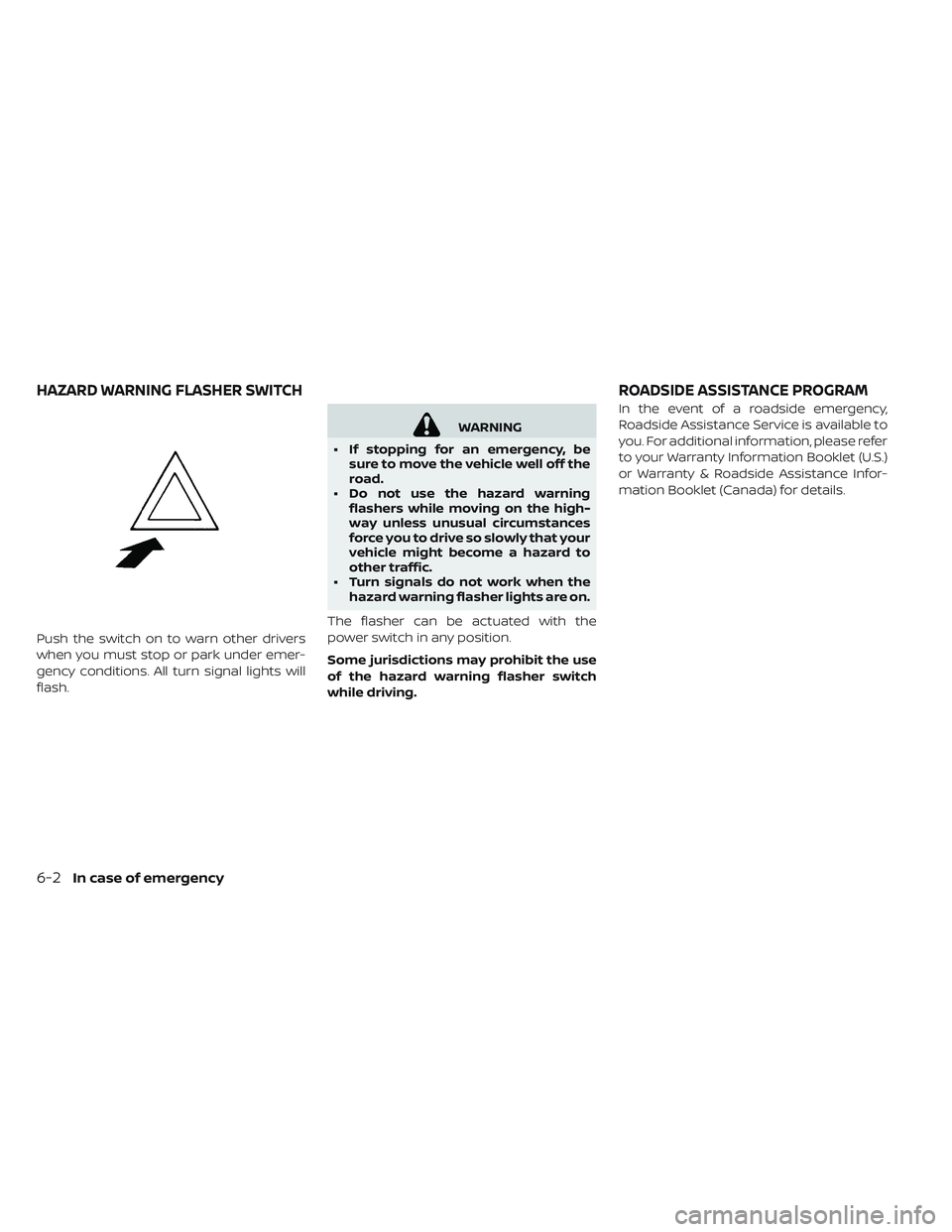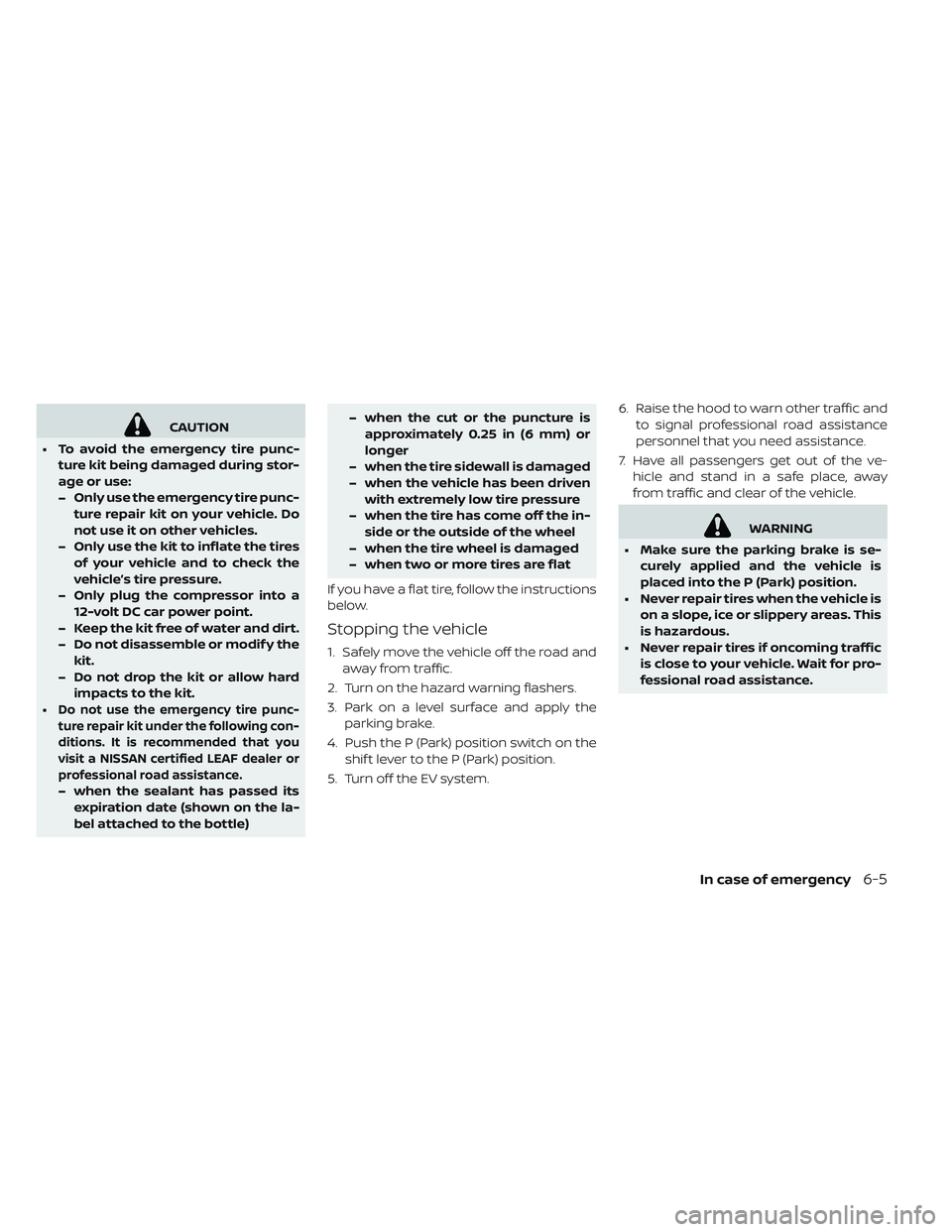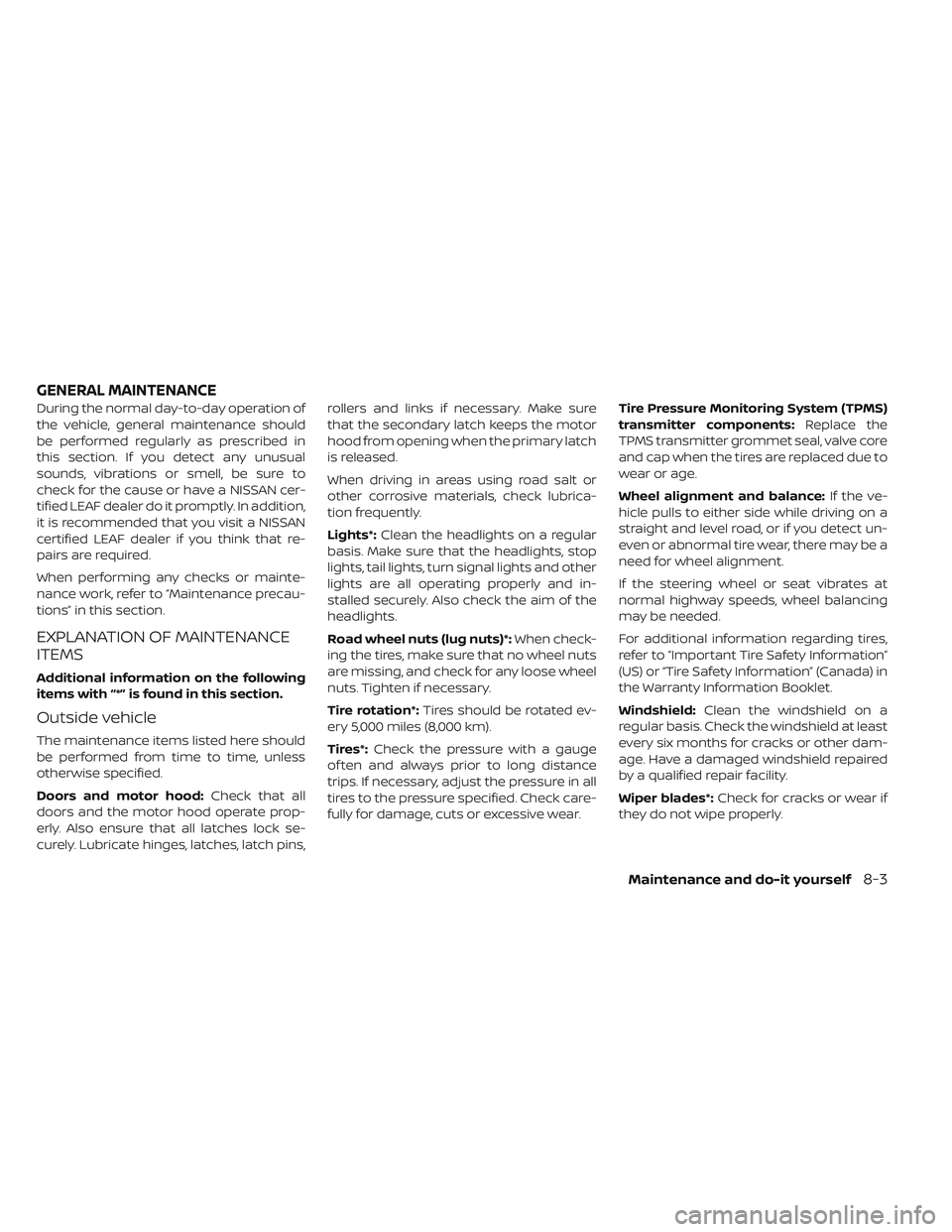2019 NISSAN LEAF turn signal
[x] Cancel search: turn signalPage 461 of 610

STEERING ASSIST
WARNING
Failure to follow the warnings and in-
structions for proper use of the Steer-
ing Assist could result in serious injury
or death.
• The Steering Assist is not a replace- ment for proper driving procedures
and is not designed to correct care-
less, inattentive or absent-minded
driving. The Steering Assist will not
always steer the vehicle to keep it in
the lane. It is not designed to prevent
loss of control. It is the driver’s re-
sponsibility to stay alert, drive
safely, keep the vehicle in the travel-
ing lane, and be in control of the ve-
hicle at all times.
• As there is a performance limit to the Steering Assist’s capability, never
rely solely on the system. The Steer-
ing Assist does not function in all
driving, traffic, weather, and road
conditions. Always drive safely, pay
attention to the operation of the ve-
hicle, and manually control your ve-
hicle appropriately. • The Steering Assist is intended for
use on well-developed freeways or
highways with gentle (moderate)
curves. To avoid risk of an accident,
do not use this system on local or
non-highway roads.
• The Steering Assist only steers the vehicle to maintain its position in the
center of a lane. The vehicle will not
steer to avoid objects in the road in
front of the vehicle or to avoid a ve-
hicle moving into your lane.
• It is the driver’s responsibility to stay alert, drive safely, keep the vehicle in
the traveling lane, and be in control
of the vehicle at all times. Never take
your hands off the steering wheel
when driving. Always keep your
hands on the steering wheel and
drive your vehicle safely.
• Always drive carefully and atten- tively when using the Steering As-
sist. Read and understand the Own-
er’s Manual thoroughly before using
the Steering Assist. To avoid serious
injury or death, do not rely on the
system to prevent accidents or to
control the vehicle’s speed in emer-
gency situations. Do not use the
Steering Assist except in appropri-
ate road and traffic conditions.
Steering Assist operation
The Steering Assist controls the steering
system to help keep your vehicle near the
center of the lane when driving. The Steer-
ing Assist is combined with the Intelligent
Cruise Control (ICC) system. For additional
information, refer to “Intelligent Cruise Con-
trol (ICC) (with ProPILOT Assist)” in this sec-
tion.
The Steering Assist can be activated when
the following conditions are met:
• The ICC system is activated.
• Lane markers on both sides are clearly
detected.
• A vehicle ahead is detected (when the ve- hicle is driven at speeds under 37 mph
[60 km/h]).
• The driver grips the steering wheel.
• The vehicle is driven at the center of the lane.
• The turn signals are not operated.
• The windshield wiper is not operated in the high (HI) speed operation (the steering
assist function is disabled af ter the wiper
operates for approximately 10 seconds).
5-102Starting and driving
Page 465 of 610

– When a sudden change in bright-ness occurs (for example, when
the vehicle enters or exits a tunnel
or is under a bridge)
– When driving on roads where the traveling lane merges or sepa-
rates or where there are tempo-
rary lane markers because of road
construction
– When there is a lane closure due to road repairs
–
When driving on a bumpy road sur-
face,suchasanunevendirtroad
– When driving on sharp curves or winding roads
– When driving on repeated uphill and downhill roads
• Do not use the Steering Assist under the following conditions because
the system will not operate properly:
–
When driving with a tire that is not
within normal tire conditions (for
example, tire wear, abnormal tire
pressure, installation of a spare tire,
tire chains, nonstandard wheels)
– When the vehicle is equipped withnon-original brake or suspension
parts – When an object such as a sticker
or cargo obstructs the camera
– When excessively heavy baggage is loaded in the rear seat or lug-
gage area of your vehicle
– When the vehicle load capacity is exceeded
– When towing a trailer or other ve- hicle
• Excessive noise will interfere with the warning chime sound, and the
beep may not be heard.
• For the ProPILOT Assist system to operate properly, the windshield in
front of the camera must be clean.
Replace worn wiper blades. The cor-
rect size wiper blades must be used
to help make sure the windshield is
kept clean. Only use Genuine NISSAN
wiper blades, or equivalent wiper
blades, that are specifically de-
signed for use on your vehicle model
and model year. It is recommended
that you visit a NISSAN certified LEAF
dealer for the correct parts for your
vehicle.
Steering Assist temporary
standby
Automatic standby due to driving opera-
tion:
When the driver activates the turn signal,
the Steering Assist is temporarily placed in
a standby mode. (The Steering Assist re-
starts automatically when the operating
conditions are met again.)
Automatic standby:
In the following cases, a warning message
is displayed along with the chime, and the
Steering Assist is placed in a temporary
standby mode. (The Steering Assist re-
starts automatically when the operating
conditions are met again.)
• When lane markers on both sides are no
longer detected
• When a vehicle ahead is no longer de- tected under approximately 37 mph
(60 km/h)
5-106Starting and driving
Page 517 of 610

Push the switch on to warn other drivers
when you must stop or park under emer-
gency conditions. All turn signal lights will
flash.
WARNING
• If stopping for an emergency, be sure to move the vehicle well off the
road.
• Do not use the hazard warning flashers while moving on the high-
way unless unusual circumstances
force you to drive so slowly that your
vehicle might become a hazard to
other traffic.
• Turn signals do not work when the hazard warning flasher lights are on.
The flasher can be actuated with the
power switch in any position.
Some jurisdictions may prohibit the use
of the hazard warning flasher switch
while driving. In the event of a roadside emergency,
Roadside Assistance Service is available to
you. For additional information, please refer
to your Warranty Information Booklet (U.S.)
or Warranty & Roadside Assistance Infor-
mation Booklet (Canada) for details.
HAZARD WARNING FLASHER SWITCH
ROADSIDE ASSISTANCE PROGRAM
6-2In case of emergency
Page 520 of 610

CAUTION
• To avoid the emergency tire punc-
ture kit being damaged during stor-
age or use:
–Only use the emergency tire punc-
ture repair kit on your vehicle. Do
not use it on other vehicles.
– Only use the kit to inflate the tires
of your vehicle and to check the
vehicle’s tire pressure.
– Only plug the compressor into a
12-volt DC car power point.
– Keep the kit free of water and dirt.
– Do not disassemble or modif y the
kit.
– Do not drop the kit or allow hard
impacts to the kit.
•
Do not use the emergency tire punc-
ture repair kit under the following con-
ditions. It is recommended that you
visit a NISSAN certified LEAF dealer or
professional road assistance.
– when the sealant has passed its
expiration date (shown on the la-
bel attached to the bottle) –
when the cut or the puncture is
approximately 0.25 in (6 mm) or
longer
– when the tire sidewall is damaged
– when the vehicle has been driven
with extremely low tire pressure
– when the tire has come off the in-
side or the outside of the wheel
– when the tire wheel is damaged
– when two or more tires are flat
If you have a flat tire, follow the instructions
below.
Stopping the vehicle
1. Safely move the vehicle off the road and away from traffic.
2. Turn on the hazard warning flashers.
3. Park on a level surface and apply the parking brake.
4. Push the P (Park) position switch on the shif t lever to the P (Park) position.
5. Turn off the EV system. 6. Raise the hood to warn other traffic and
to signal professional road assistance
personnel that you need assistance.
7. Have all passengers get out of the ve- hicle and stand in a safe place, away
from traffic and clear of the vehicle.
WARNING
• Make sure the parking brake is se-
curely applied and the vehicle is
placed into the P (Park) position.
• Never repair tires when the vehicle is
on a slope, ice or slippery areas. This
is hazardous.
• Never repair tires if oncoming traffic
is close to your vehicle. Wait for pro-
fessional road assistance.
In case of emergency6-5
Page 542 of 610

During the normal day-to-day operation of
the vehicle, general maintenance should
be performed regularly as prescribed in
this section. If you detect any unusual
sounds, vibrations or smell, be sure to
check for the cause or have a NISSAN cer-
tified LEAF dealer do it promptly. In addition,
it is recommended that you visit a NISSAN
certified LEAF dealer if you think that re-
pairs are required.
When performing any checks or mainte-
nance work, refer to “Maintenance precau-
tions” in this section.
EXPLANATION OF MAINTENANCE
ITEMS
Additional information on the following
items with “*” is found in this section.
Outside vehicle
The maintenance items listed here should
be performed from time to time, unless
otherwise specified.
Doors and motor hood:Check that all
doors and the motor hood operate prop-
erly. Also ensure that all latches lock se-
curely. Lubricate hinges, latches, latch pins, rollers and links if necessary. Make sure
that the secondary latch keeps the motor
hood from opening when the primary latch
is released.
When driving in areas using road salt or
other corrosive materials, check lubrica-
tion frequently.
Lights*:
Clean the headlights on a regular
basis. Make sure that the headlights, stop
lights, tail lights, turn signal lights and other
lights are all operating properly and in-
stalled securely. Also check the aim of the
headlights.
Road wheel nuts (lug nuts)*: When check-
ing the tires, make sure that no wheel nuts
are missing, and check for any loose wheel
nuts. Tighten if necessary.
Tire rotation*: Tires should be rotated ev-
ery 5,000 miles (8,000 km).
Tires*: Check the pressure with a gauge
of ten and always prior to long distance
trips. If necessary, adjust the pressure in all
tires to the pressure specified. Check care-
fully for damage, cuts or excessive wear. Tire Pressure Monitoring System (TPMS)
transmitter components:
Replace the
TPMS transmitter grommet seal, valve core
and cap when the tires are replaced due to
wear or age.
Wheel alignment and balance: If the ve-
hicle pulls to either side while driving on a
straight and level road, or if you detect un-
even or abnormal tire wear, there may be a
need for wheel alignment.
If the steering wheel or seat vibrates at
normal highway speeds, wheel balancing
may be needed.
For additional information regarding tires,
refer to “Important Tire Safety Information”
(US) or “Tire Safety Information” (Canada) in
the Warranty Information Booklet.
Windshield: Clean the windshield on a
regular basis. Check the windshield at least
every six months for cracks or other dam-
age. Have a damaged windshield repaired
by a qualified repair facility.
Wiper blades*: Check for cracks or wear if
they do not wipe properly.
GENERAL MAINTENANCE
Maintenance and do-it yourself8-3
Page 564 of 610

1. Headlight assembly
2. Map light
3. Room light4. High-mounted stop light
5. Rear combination light6. Door mirror turn signal light (if so
equipped)
7. Cargo light
8. License plate light
9. Fog light (if so equipped)
Fog may temporarily form inside the lens
of the exterior lights in the rain or in a car
wash. A temperature difference between
the inside and the outside of the lens
causes the fog. This is not a malfunction. If
large drops of water collect inside the lens,
it is recommended that you visit a NISSAN
certified LEAF dealer for this service.
HEADLIGHTS
If headlight bulb replacement is required, it
is recommended that you visit a NISSAN
certified LEAF dealer for this service.
Replacing the LED headlight bulb
(if so equipped)
If LED headlight bulb replacement is neces-
sary, it is recommended that you visit a
NISSAN certified LEAF dealer for this service.
LIGHTS
Maintenance and do-it yourself8-25
Page 566 of 610

EXTERIOR AND INTERIOR LIGHTS
ItemWattage (W)Bulb No.
Headlight assembly (Type A)
(if so equipped)* High* 60HB3
Low* 55H11
Park/Turn signal* 28/87444NA
Side marker* ——
Headlight assembly (Type B)
(if so equipped)* High* ——
Low* ——
Daytime running (if so equipped)* ——
Park/Turn signal* 28/87444NA
Side marker* ——
Front fog light (if so equipped)* 35H8
Charge port lid light* ——
Rear combination light Turn signal 21WY21W
Stop/Tail* ——
Back-up 16W16W
Side marker* ——
License plate light* 5W5W
Map light* ——
Door mirror turn signal light (if so equipped)* ——
High-mounted stop light* ——
Vanity mirror light* 1.8—
Glove box light* 1.4—
Room light* 8—
Cargo light 5W5W
*It is recommended that you visit a NISSAN certified LEAF dealer for replacement.
NOTE:
Always check with the Parts Department
at a NISSAN certified LEAF dealer for the
latest information about parts.
Maintenance and do-it yourself8-27
Page 609 of 610

Towing...................6-14, 9-13
Towing a trailer .................9-13
TPMS, Tire Pressure Monitoring System . . .5-4
TPMS, Tire pressure warning system .....6-3
Traction motor ..................9-8
Traction motor serial number .........9-8
Trailer towing ..................9-13
Transceiver ...................2-75
Transceiver, HomeLink® Universal ......2-75
Transmitter, With Intelligent Key system
(Refer to Intelligent Key system) .......3-14
Trickle charge .........CH-11, CH-17, CH-25
Turn signal switch ...............2-59
Type of charge and how to charge the Li-ion
battery .....................CH-5
Types of tires ..................8-36
U
Underbody cleaning ...............7-3
Uniform tire quality grading ..........9-13
Unplugged status ..............CH-50
USB (Universal Serial Bus) connection
port........................4-61
V
Vanity mirror ..................3-24
Vehicle ..........2-48, 5-150, 9-6, 9-7, 9-10
Vehicle dynamic control (VDC) system . .5-150
Vehicle identification number (VIN) ......9-7
Vehicle information display .........2-28
Vehicle security system ............2-48
Vents .......................4-30
W
Warning ........2-15, 2-17, 2-37, 5-4, 6-2, 6-3
Warning and indicator lights .........0-12
Warning labels, Air bag warning labels . . .1-61
Warning light .........1-61, 2-18, 2-19, 2-20,
2-21, 2-23, 2-24
Warning lights ..................2-17
Warning lights, indicator lights and audible
reminders ....................2-15
Washer switch ..............2-50, 2-52
Washing ......................7-2
Waxing .......................7-2 Weights (Refer to Dimensions and
weights)
......................9-6
Wheel/tire size ..................9-5
Wheels and tires ..............7-3, 8-30
When starting and driving ...........5-4
When traveling or registering your vehicle in
another country .................9-7
Window(s) ..................2-70, 7-3
Windshield wiper and washer switch . . . .2-50
Windshield-washer fluid ............8-11
Wiper ..........2-50, 2-52, 8-15, 8-16, 8-17
Wiper blades ...............8-15, 8-16
With Intelligent Key system
(Refer to Intelligent Key system) .......3-14
10-6Index